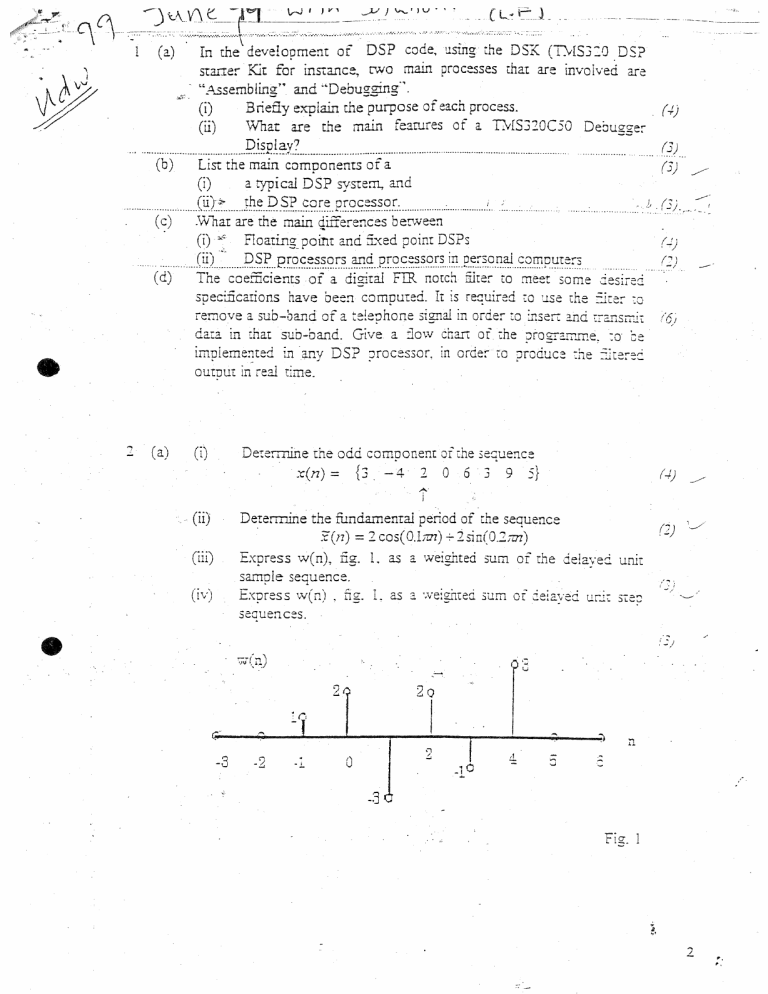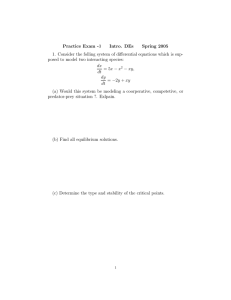
";...,
..
--'
...
.
q C"\-=~~~~:-~==~~:::~,.:-'.~===~,~:'~ :. ":.:.~
. -1
...
. '. .'.
(a)' In the development of DSP code, using the DSK (TvIS3:0 .DS?
staner Kit for instance, tiNO main processes iliar are involved are
~'.A..ssembiing'" and '4Debug:mng~'.
:::s:·
......
............
(i)
Briefly explain the purpose of each process.
(-/.)
(ii)
\Vh.at are the main fearures of a r:vfS320C50 De8ugger
Disnlav?
.........................................................................................................................................................................
. .......................... (~J.. .
(b)
List the main components of a
(3) ././
(i)
a typical DSP system., and
.............................(~)-.~..... Jh.~..P.~?~g~~. p.~~.~.~~.?.9.t·...................:................ :.. .......... ..........
.. .......................:: .l::/~) ., ... :~
,vVhat are the main qifferences benveen
(i) ~~ F10 at ing. point and :L"{ed pain! DSPs
(..!)
.................U~} . ~~.......p..~?. p~g.~.~~.~g~?...~~..PE~~~.~~gE~. !~. p.~~~g.~.~ ..~?.~P~~ ~r.~... .
(2)
(d)
The coefficients of a digiTal FIR no(ch filter to meet some 2eSIred
specifications have been computed. It is required ~o use the ::iter :0
remove a sub-band of a te!ephone signal in order to ~1serc and ~I'2.nsrniL /6)
dara in that sub-barld. Give a :10\V chart or i:he ?rogr2.l7UTIe~ :0· be
implerne!1ted in any DSP ?rocessor, in order to produce :he :::1terec:
outnut in real time.
(c)
•
(a)
the odd component or 'Che sequence
x( n) = {3. - 4· 1 0 6· 3 9 5}
De~ermine
(i)
(-/.)
.,./'
(2)
.../
.......
j
. (ii)
De.termine the fundamental period of (he sequence
x(n) = 2 cas(O.Lrn) -:-2sin(O.2;m)
Express w( n), fig. 1. as a weighted sum of Ihe de!ayed. unit:
samnle
seauence.
,
Express ~N(n) , fig. L as 1 ',ve:gm:ed sum or ie~2.yed uri: sLe~
sequences .
(iii)
.
(iv)
•
~\i(n)
-.~
~ ("I
-J
C
-3
-2
~
-
I
20
21
0
I
.J
"~
;
n
f
-1 0
Fig. 1
2
~.
;
.
.- ,'---.'. ----- --------- LtS-inout.ls.~cive:1 bv .
•
_
J
where~
u(n) is a step sequence.
Use the difference equation to comput.e. output signal values y(O) to
(6')
,
.__~. __ ..... __.__ ... _... .Y(~t~~.!~.~~y.~:...gj~~~..~~ ..~.~.~~.. ~.9.~~;.~i9.~~..Y.(:~}.~.y(:.U.. ~ ..?:. ,. . . :................... .
(c) The impulse response of an LTI system is given (7)
by hen) == u(n) - u(n - 4) . Bv means of graphical convolution
deterrrme the output of the system if the inpuT IS glve~ bv .
-\/
x(n) == u(n) - u(n - 7) . \;Ynere u(n) is a step func:ion.
(a)
.J
The Discrete Fourier Ser:es for oenodic secuer:.ces is 21ver: QV
~
•
V-I
,y(z,.'l·-~Y('n)'w"-Cr
w'n'i::>~<::> WV
L·"..'I
.-
,1"1
'-'4'-
-
""enoc';c "e
:"
.I.
10.
.-:c~ (n)
'..
::)
nl1
""":. \000*
e""co.s
...
l"epresem:s
.......
_
p-I"'\~'e
i. V I
~he
.
•
=;,)-,'*
-
"MQ:
cu . . . ;;'(n)
. \
-
t1
/'r'YI/1'
'-L/~:";'
_Y((I~'\"
__
•
;:;r:=o
...._
a "'rooe-r--t·
-1..,e :ollc "!;-;n=
t'
.
'wi.L
1
j".
"rv
U.
.L
L ..'"
even compone::t of~he seque!1ces
~(n) .
................. :: ................................ ,. .....................................................................................................................................................
(b)
Determine rhe periodic sequence len) obtained by a periodic
convolution of two periodic sequences of length 4 each
(0 jor n =0
/ 1 for n = 1
x(n)=jo for n=2
f2 for n =0
_
0 Jor n = 1
h(n)=jl for n=2
=3
l 0 jor n = 3
l::z for
n
.
(i)
(c)
•
"-~~
j" . .
:~.
(fJ
;.1 •./ ...
'
I]
0 0 :J
0).
\.virh
""'eriod
..
7"
\;=1
.....
n
..,J..
·P10-L -;,~
~
~ .. ",-,
~
..,.
i;) .
.
.
:.,
(l
x(n) = ~
.
(a)
Explain the distinction benveen
(i)
the discrete Fourier Series (DFS) and the Discre~e Fourier
Transform (DIT)
(ii)
the Discrete-time Fourier Transform (DTFT) and the Discrete
F.ou~er Transform (DFT)
.A. discrete time signal has the following sample values {L 2, 1, :3}.
V/hat are the real and imaginary pares of the DFT coefficients X(k).
(3)
(5)
r:)-,-V
3
~1c"Or:·~:",....,·
.
.~=
: /.
®
!.. ....... 11..
radi.'(-2
- ~ \o.,..}~ \~-;~.-C.-::J~..(J '2o.J.. )-:'c -:.A:- ';)r..11)
d
'
.
.. ;,....,e
'J..-J -'
:r...(. . . . . ".".. .,..,.,... ..,,~JeClmatI on -:'n-tlul
";("....... (
~¥~ (iii) butterfly
~0~J ' \ - )
.
(tv)
t\¥iddle facor
(v)
shuffled input
natural-order output
................... .............................................
...........(.)
"0..........................................................................
.
(i)
, .
!
....
'";t....!.J..
.-.,
,
(12)
,
................... .
1
A si£!lai has the z-~ransIor:n )t( =) = ()~
-
.
= - 1 (2= - l)
. Cse the method
of par::ial frac:ions. together '.\lith taDles provided to recover'. the ·
(b)
.~.~gn.~~.. :~(? t.. . .
.......
FineL using: che Lesidue method. the
(6)
dis~ete
time sequences·
. corresponding to
1 __
',T( __) -_ ""---_ _
(= - 0.5)(= - O.9t
The transfer func:ion of a disc:-e:e-time· sYSl:em has poles at z=0.5 .
z=0.1::jO.2 and athirdorderz:ero 3.rz=-13J1dz=1.
Comment on the staoiliry or :he sYSl:e::1.
(i)
(ii)
From the :ransfer func:1on of the SYSTem develop the:
difference equation relat1.T1g The output yen) t.o the input x(n).
Draw the realisation diagram in signal flowgraph form.
(iii)
A
.-,:""
(c)
5
•
(a)
(0)
...,-' ·i f-
\-. '..- 1. / "
1'/
FIR filter has an impulse response~ hen), which is defined over -che •
iileer-val 0 :s; n s: ~V - 1. Show :hat ir~ N is 5 and h(n) satisfies the.
?ositive SYrnI1:1e~~y, thar is h(I1)=~C:';-!l-l), the 5.lter has Linear phase.
Eim:~ Ob[ain an expression :Or :i1e ·-a.mpiitude and phase response of·
tr-le iJlter.
The normalised :ransier tUncrion ·o{ an anaio~Je RC filter .is given by .
(6)
(4)
.!".11
1
H(s) = - - . A di2i!al eauivaler.:
.
---,'
'" ;
( .::./
5-7-"1
-
•
or the RC
fiiter, \vlth
3.
(j 0)
cut-off
E-equency 30 F...z is ~equired. T:1e sampiing frequency IS l50 Hz..
Csing the Bilinear z-~ransforw (EZT) method,
(i)
determine the transfer func::on.
(ii)
give the difference equation. and
(iii)
draw the block diagram representation ofrhe digital filter.
(3)
(-J)
(3)
The ::.-transform and its applications in" signal processing
Table3.1
Emry
num[u:r
1
z-transfonnsof some'common sequences.
Discrere-cime
seq u. ence
z( n)
n.?: 0
:'-Iraltsfonn
Region of
convergence
X(z)
of X(z)
9
k:
k6{n)
,
2
xz
k
;: -
k:
kn
. :. 1)
(: -
i)~
Cl
(.: -
e-~):
:(1 -
e-~)
~;; ....,.,~"<l
~
cos (an)
,r~~~~.'
9
sin (an)
10
e -<r1l sin ( an)
12
cosh (an)
13
sinh (an)
. .:. ~... -:r) ..:..
",-0'w
;:z( z: - cos c.-)
Zl -
(z - cry:.
C"
.
COSJ
c:
1':/ > a:
krr:::.
.: ez
,
i.:; >
.: sinh cr
2.: cosh cr -:- 1
k:
15
2!c! !pl" cos (nip + Ie)
[zl> 1
,
:: - 2: cosh cr -:- 1
ker"
16
1.:1> 1
2z cos cr -:- 1
z:. . .,. 2:. cos cr + 1
ZZ -
k and
;zi> :
k:
7
•
k::.( z
5
8
Iz/ > l
(:: - IF·
'79.·
•
1.::1> :
J.
l.:i > c:
c"':
---+--z- p z: - p*
are constants; c is a complex nurnbe:-; ..
I.



